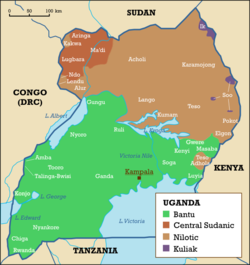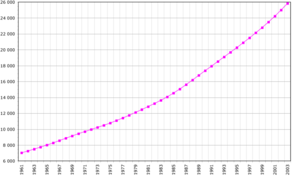Demographics of Uganda
2007 Schools Wikipedia Selection. Related subjects: African Geography
Africans of three main ethnic groups – Bantu, Nilotic, and Central-Sudanic (traditionally called Nilo-Hamitic) – constitute most of the population.
The Bantu are the most numerous and include the Baganda in the central area (18%), Basoga in the south-eastern area (11%), Banyankole in the south-western area (8%), Bakiga in the most south-western area (8%), Banyoro in the mid-western area (3%), Batoro/ Batooro in the mid-western area (3%), Bagisu int the eastern area, Bahima in the south-western area (2%), Banyaruanda in the south-western area (6%), and other much smaller ethnic groups.
Residents of the north, largely Nilotic, are the next largest group, including the Langi, 6%, and the Acholi, 4%. In the northwest are the Lugbara, 4%. The Karamojong, 2%, occupy the considerably drier, largely pastoral territory in the northeast. Europeans, Asians, and Arabs make up about 1% of the population with other groups accounting for the remainder.
More than half of the population is under the age of 14 – more than any other country in the world.
Uganda's population is predominantly rural, and its density population highest in the southern regions. Until 1972, Asians constituted the largest nonindigenous ethnic group in Uganda. In that year, the Idi Amin regime expelled 50,000 Asians, who had been engaged in trade, industry, and various professions. In the years since Amin's overthrow in 1979, Asians have slowly returned. About 3,000 Arabs of various national origins and small numbers of Asians live in Uganda. Other nonindigenous people in Uganda include several hundred Western missionaries and a few diplomats and businesspeople.
Statistics
Population: 24,699,073
note: estimates for this country explicitly take into account the effects of excess mortality due to AIDS; this can result in lower life expectancy, higher infant mortality and death rates, lower population and growth rates, and changes in the distribution of population by age and sex than would otherwise be expected (July 2002 estimate)
Age structure:
0-14 years: 50.9% (male 6,314,371; female 6,265,681)
15-64 years: 47% (male 5,803,430; female 5,789,713)
65 years and over: 2.1% (male 247,798; female 278,080) (2002 estimate)
Population growth rate: 2.94% (2002 est.)
Birth rate: 47.15 births/1,000 population (2002 estimate)
Death rate: 17.53 deaths/1,000 population (2002 estimate)
Net migration rate: -0.28 migrant(s)/1,000 population
note: according to the UNHCR, by the end of 2001, Uganda was host to 178,815 refugees from a number of neighboring countries, including: Sudan 155,996, Rwanda 14,375, and Democratic Republic of the Congo 7,459 (2002 est.)
Sex ratio:
at birth: 1.03 male(s)/female
under 15 years: 1.01 male(s)/female
15-64 years: 1 male(s)/female
65 years and over: 0.89 male(s)/female
total population: 1 male(s)/female (2002 estimate)
Infant mortality rate: 89.35 deaths/1,000 live births (2002 estimate)
Life expectancy at birth:
total population: 43.81 years
male: 42.97 years
female: 44.67 years (2002 estimate)
Total fertility rate: 6.8 children born/woman (2002 estimate)
HIV/AIDS:
adult prevalence rate: 6.1% (2001 estimate)
people living with HIV/AIDS: 1.1 million (2001 estimate)
deaths: 110,000 (1999 estimate)
Nationality:
noun: Ugandan(s)
adjective: Ugandan
Ethnic groups: Baganda 17%, Ankole 8%, Basoga 8%, Iteso 8%, Bakiga 7%, Langi 6%, Rwanda 6%, Bagisu 5%, Acholi 4%, Lugbara 4%, Batoro 3%, Bunyoro 3%, Alur 2%, Bagwere 2%, Bakonjo 2%, Jopadhola 2%, Karamojong 2%, Rundi 2%, non-African (European, Asian, Arab) 1%, other 8%
Religions: (from 2002 census) Christianity 85.1% ( Roman Catholic 41.9%, Church of Uganda 31.9%, other Protestant 10.3%, other Christian 1%), Islam 12.1%, indigenous beliefs 1%, other 0.7%
Languages: English (official national language, taught in grade schools, used in courts of law and by most newspapers and some radio broadcasts), Ganda or Luganda (most widely used of the Niger-Congo languages, preferred for native language publications in the capital and may be taught in school), other Bantu languages, Nilo-Saharan languages, Swahili, Arabic
Literacy:
definition: age 15 and over can read and write
total population: 62.7%
male: 74%
female: 54% (2000 estimate)

